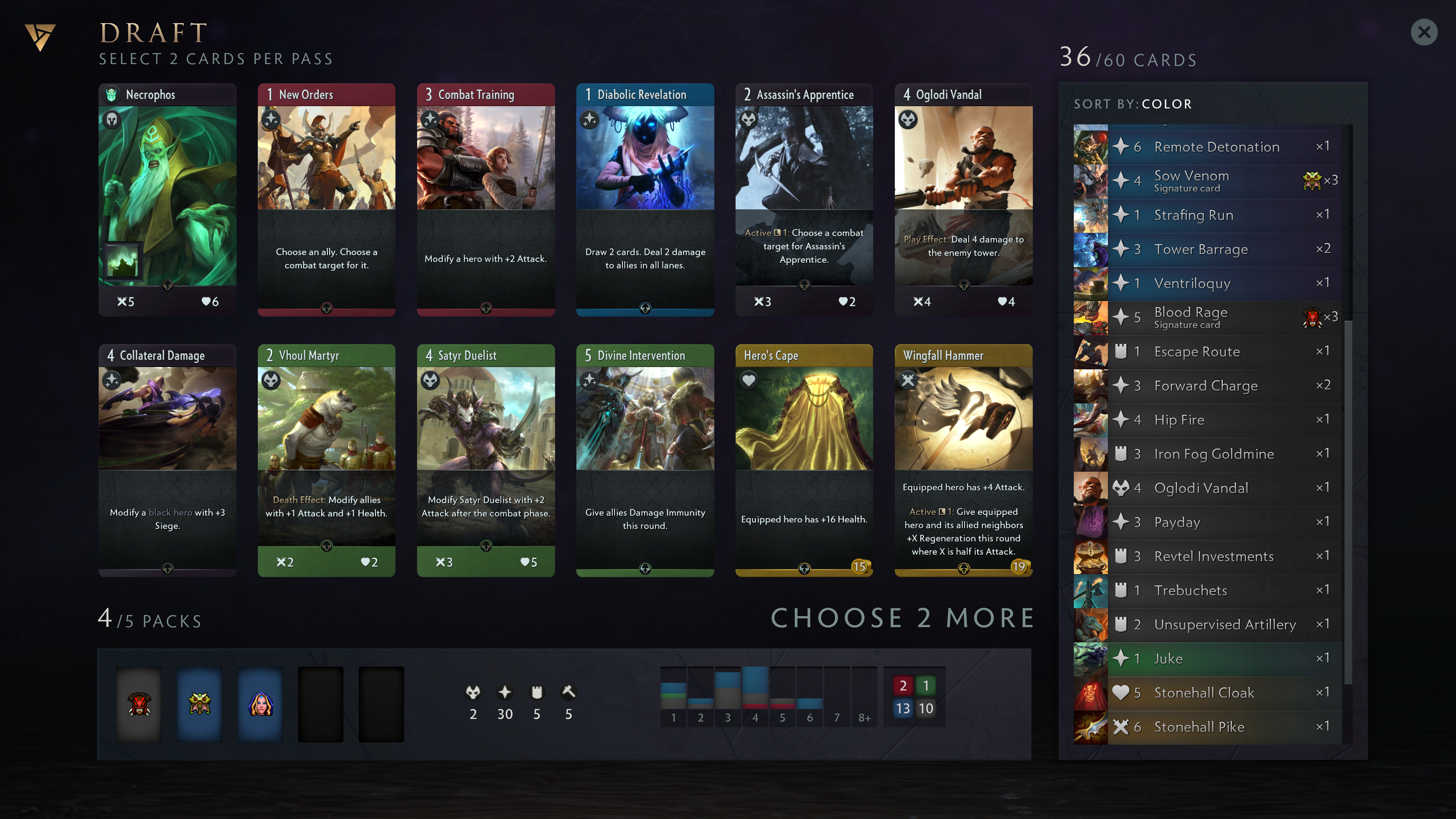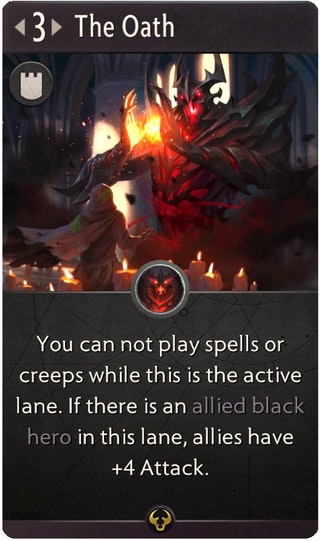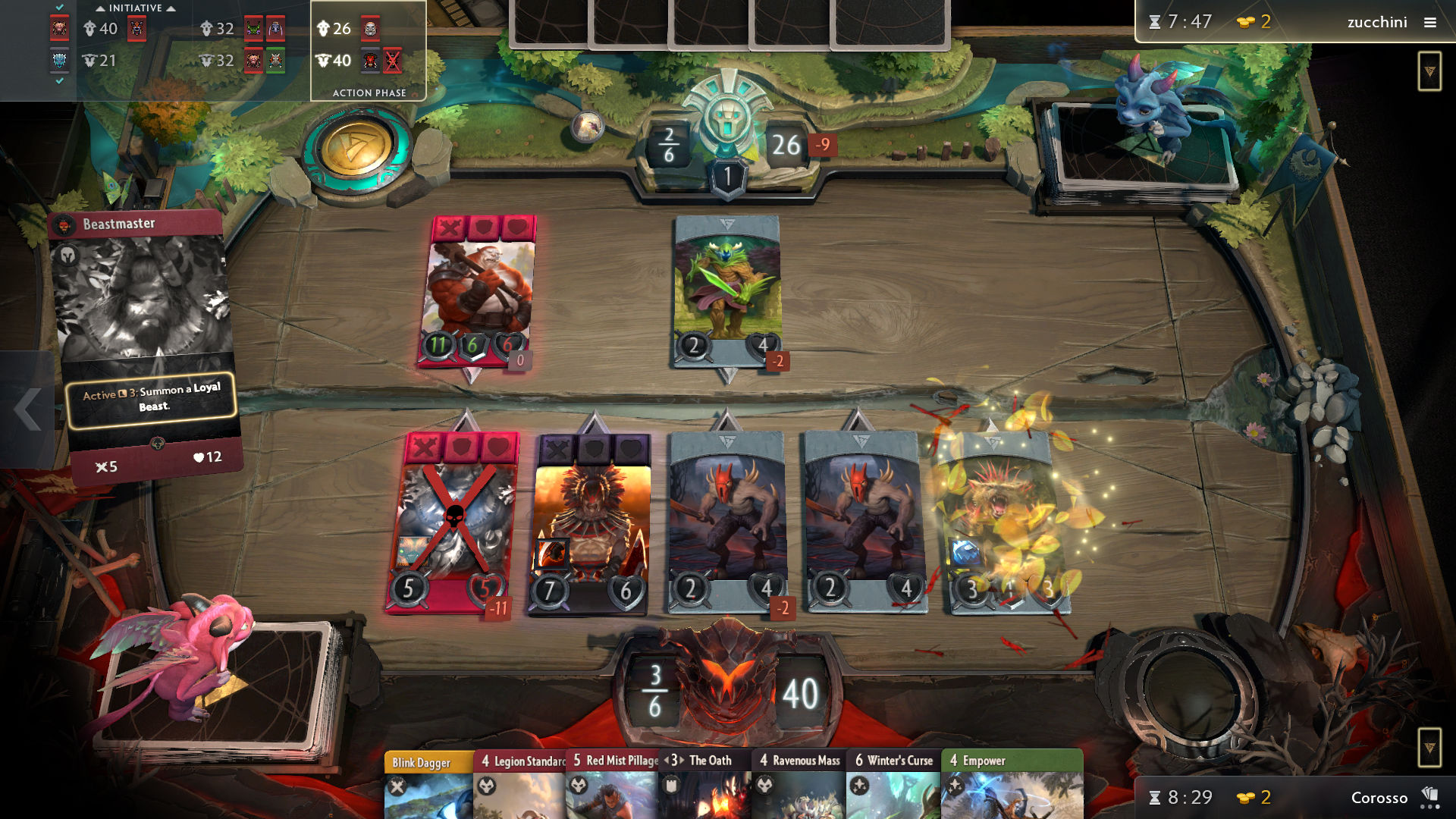
Artifact is almost upon us, and for Valve the timing feels just about perfect. At some point later this month the Dota-themed card game will transition from closed beta—currently populated by a mix of Dota scenesters and pros from rival CCGs—to a more open affair. Beta keys are bound to be hot property given the level of interest in Valve's first non-VR game in more than five years. Meanwhile, the current CCG king is in a funk. No one deck or card is to blame, but Hearthstone is being heavily criticised by high-level players who've grown tired of the annual three-set release cycle delivering largely the same experience, a situation compounded by the recent cancellation of a planned tournament mode.
Elsewhere, the release of The Elder Scrolls: Legends' shoddy new client saw its community implode. In stark contrast, the success of Magic: The Gathering Arena means the best-known physical card battler is finally making a good fist of digital. That's also good news for Artifact, since Magic's more hardcore style could pave the way for Valve's complex three-lane structure. And hey, it doesn't hurt that both games are the brainchild of the same legendary designer: Richard Garfield. He was on hand this week to oversee our latest Artifact playtest, paternally pointing us towards the best cards to pick, and grinning less sympathetically as spectacular pyrotechnics consumed our board.

Bolts from the blue
Last time I visited Valve's Bellevue HQ, it was to get acquainted with Artifact's core mechanics. I left happy but with something of a headache due to the sheer amount of information you're expected to parse, evaluate, and use to form a game-winning plan. This time we'd been invited to check out the Sealed mode, but warmed up with a standard game first.
The deck I was given was called 'Blue Bolt', and as with my previous experience playing Blue, the aim was to stall long enough to bring flashy but expensive board clear spells online. My opponent's deck, 'Green Thunder', included a lot of mana ramp effects, which meant contending with oversized 'Creeps' earlier than normal. Creeps are Artifact's non-hero minions, two of which are spawned into random lanes each turn, but larger variants can also be summoned by spells and other effects.
It's a game-ending nuke that makes Hearthstone's Pyroblast look like a laser pointer.
Despite taking an early battering, I was able to reset the problematic middle lane using the Annihilation spell (which is basically Blue's "Oh shit" button), and edged narrowly ahead in the other two lanes. Artifact's natural draw step (i.e. the one that happens at the start of each turn) grants two cards, which means less pressure to include a bunch of cycle effects during deck building. The game was going long and things were tense, until suddenly they weren't: I top-decked double Bolt of Damocles, which for the princely sum of 10 mana does 20 damage to the opposing tower. It's a game-ending nuke that makes Hearthstone's Pyroblast look like a laser pointer, and because it was turn 10, and in Artifact you can spend your full complement of mana in each lane, I was able to cast Bolt in both of the contested lanes. The game ended in a fizz of crackling destruction.
Immediate reaction: Sucks to be the other guy. More considered reaction: Since I last saw Artifact, its UX has been cleaned up to make shuttling between lanes more intuitive and the function of cards and their effects easier to understand. This time I also found the notion of passing initiative back and forth much easier to follow. Note that, unlike Hearthstone, you don't spend an entire turn doing all your stuff and then hand the reins over. Instead, after each action your opponent has a chance to respond.
Note: The game above shows the Blue Bolt deck vs Green Thunder, but isn't the match described in this article.
Keep up to date with the most important stories and the best deals, as picked by the PC Gamer team.
Unless you're playing an aggressive deck, that means quite a bit of passing without playing anything early on, but once the boards fill up you'll find yourself in complex back and forths that can eat up the turn timer. Interestingly, the timer is shared across all three lanes, meaning if you use most of it up worrying about what to do in the first lane, you'll have less time to think in the second and third. This proves problematic when Valve's watching brain trust offers conflicting advice on how to stay alive, but more on that in a moment.
Sealed and delivered
Next came the meat of our session: the Sealed mode. This is a 'limited' mode, in the sense that you aren't reliant on your own card collection, but instead open a set number of booster packs from which you pick cards to build your deck. Once the game enters full release, these packs will be shared with other other sealed players, but opened asynchronously. That means you won't have to wait for a particular player to choose the cards they want from your pack. Thousands of half-opened packs will be circulating at any moment, and as soon as you've made a selection you'll be served another spare one.
To draft your deck, you open five packs in total, each of which contains 12 cards. Of these, two will be items, one will be a hero, and at least one will be a rare. Unlike Constructed, you can pick the same hero more than once—according to pro player Paulo "PVDDR" Vitor, double Luna is the scourge of closed beta Sealed—but regardless you'll always end up with five in total. And if you somehow fail to pick five heroes from the packs, basic versions will be offered at the end to fill out your roster. These heroes are essentially the kids picked last for gym so you'll want to avoid getting stuck with them.

For our draft, we got a pretty sweet selection. I say 'we' because picking with me was Chris Thursten, a Dota 2 fiend and card game aficionado once of PC Gamer's parish, and the guy who's writing the magazine's forthcoming Artifact cover feature. If you've drafted decks in other CCGs, you'll know that your first few picks tend to be based on raw power. Keep picking based on card quality and gradually potential play styles will emerge based on the synergies you've accrued. Having plumped early for the big pile of Red stats that is Bristleback, and having found the Black heroes Storm Spirit and Sniper soon after, we quickly decided on a punchy Red/Black deck.
When you're done with the initial picks, it's time to whittle your selection down from 60 cards to around 40. A key consideration here is each hero's signature spell, three copies of which will be added to your deck automatically. Chris and I decide to include Bounty Hunter, largely on the basis of his spell 'Track'. For 3 mana, this adds +10 Bounty to an enemy hero currently in play. Upon that hero's death, you'll receive 10 extra gold to spend in the shopping phase between rounds. Shopping is crucial in Artifact, because it's here you buy not just the items you've included in your own deck (Valve's devs recommended around nine, and who were we to argue?), but also items from two other pools—one containing basic consumables like health potions, the other featuring every item in the game.

Obviously that wasn't quite enough RNG for us, so based on our gold-grabbing strategy we convinced ourselves it would be okay to include one copy of Apotheosis Blade, a 25 gold weapon with enough card text to start a short story. (Look, when you're offered the flaming sword, you take the flaming sword). More problematically, we also plumped for two copies of Golden Ticket, a 9-gold item which converts into a completely random item from the store. Garfield looked on with a mixture of pride and horror, but we figured two was definitely correct. After all, what if we didn't draw one?
Feeling drafty

We rounded out our monstrosity with a mixture of hard-hitting creeps like Bronze Legionnaire and Sister of the Veil, plus multiple copies of cards that either buffed the Attack of our heroes or gave them the Siege effect. Siege enables characters to deal damage to the tower even if they're being blocked, and our deck didn't like being blocked. We also picked a couple of cards like No More Magic and The Oath that shut down spellcasting. Our plan was to end the game fast, picking off opposing Heroes with Sniper and a smattering of hard removal cards such as Slay, then using the pile of gold to buy items that would juice up our big Red beat sticks. The strategy was sound. The synergies were strong. What could stop us?
It turns out the bullies at Valve could stop us. Despite a decent early push during which Tidehunter's enormous butt helped jam up the middle lane as we pushed for damage on the left and right, our opponent, (who, let the record state, must be the kind of brainiac that makes it through Valve's hiring process), used a spell that manipulated two of our heroes into attacking and killing each other. "That was bad," noted one of his watching colleagues, understatedly. Despite all the advice coming from the gallery, it felt to me like even our best lines of play were merely stemming the bleeding as multiple Eclipse spells cleaned our boards out. Also, our Golden Ticket gave us something completely lacklustre like a mid-tier cloak. No war has been won with cloaks.
Note: As before, the video above is not the match described in the article.
Nonetheless, we plugged away until a previously unannounced spell called 'At Any Cost' completely wrecked our remaining forces not once, but twice. It's a Blue spell that deals 6 damage to every unit and only costs 3 mana. Suffice to say the effect is as spectacular as it is painful. "Pretty ironic losing to the card we're giving you to put on the cover," offered another of the Valve guys. And so the cycle was complete. I looked at the deck we'd drafted, which despite no supporting evidence I'd convinced myself was unstoppable, and saw it for the garbage fire it actually was. But I also couldn't wait to draft another.
Sadly there was no time for that, as we wrapped up our visit with a Q and A. The first thing I wanted to ask about was the cost of the game. Artifact will use an 'open' economy, in the sense that players can buy and sell cards on the Steam Marketplace, in stark contrast to most other digital CCGs. Recently, I've seen a couple of streamers—Reynad and Kripparian, most notably—discussing whether this will inevitably mean the best deck in the game becomes the most expensive due to inflated demand for its cards.
"If there’s one expensive deck, maybe there will also be ten cheap decks," said Valve's Skaff Elias. "We definitely want to make sure it’s a reasonable price for people to play." Gameplay programmer Brad Muir added that: "The original philosophy of ‘rarity does not equal power level’ is more pronounced here. I think there will be decks that have a decent number of commons and uncommons inside of them. In the case of common cards, they’ll be so abundant that the price [of those cards] will have a hard time getting off the floor."

The other advantage, of course, is that you aren't stuck with the cards you've opened. "Having the market means that if you want to try a different type of deck you can sell the cards you have," said Valve's Jeep Barnett, who's been working on the game for two years. "You can take your investment and turn it into something else."
I was also curious to know how Valve felt about the closed beta giving the pros in it an unfair advantage in the nascent competitive scene, particularly with a $1 million tournament already announced. "The tournament isn’t a week or even a month after release, so I think it’ll even out after a bit," said Muir. He also pointed out that these players will serve an important secondary function for Valve in that they'll be the ones most likely to create videos and written content explaining the game and its strategies to new players.
Finally, I wondered whether Valve wasn't worried about a player like Stanislav "StanCifka" Cifka apparently putting up an 80% winrate in the closed beta's sealed mode. That's almost unheard of consistency for a card game, and seems potentially unhealthy. "It's good for the game, at this stage," countered Garfield. "We want there to be a great deal of skill in this game. That gap will narrow as people learn the basics. There’s enough different things going on in Artifact that it’s not surprising to see that sort of gap at this point."
There, perhaps, you find the fundamental difference between Artifact and its rivals. There's so much happening in each match, between managing the three lanes, worrying about your gold count, deciding where returning heroes should be placed, and much more, that the gap between pros and scrubs is likely to be vertiginous. That should also make it an interesting game to cast and spectate, because I imagine we'll regularly see plays that wouldn't have even crossed most of our minds. Unless of course you're Richard Garfield. In which case you'll just give that knowing smile.
For more on Artifact check out the next issue of PC Gamer magazine, on sale in the UK on November 15th and in the US on December 4th. Subscribe here.

With over two decades covering videogames, Tim has been there from the beginning. In his case, that meant playing Elite in 'co-op' on a BBC Micro (one player uses the movement keys, the other shoots) until his parents finally caved and bought an Amstrad CPC 6128. These days, when not steering the good ship PC Gamer, Tim spends his time complaining that all Priest mains in Hearthstone are degenerates and raiding in Destiny 2. He's almost certainly doing one of these right now.


